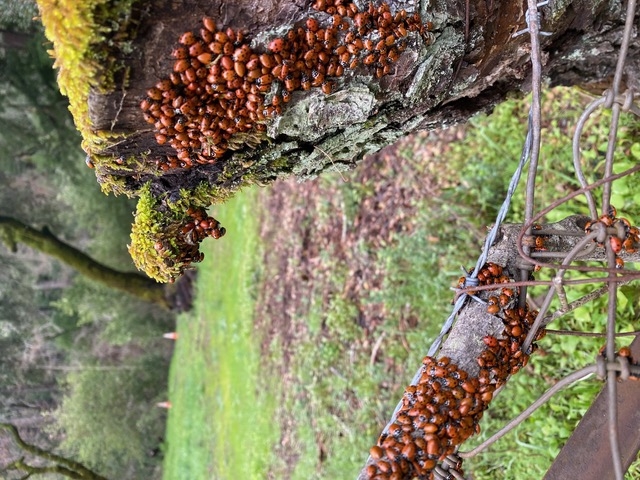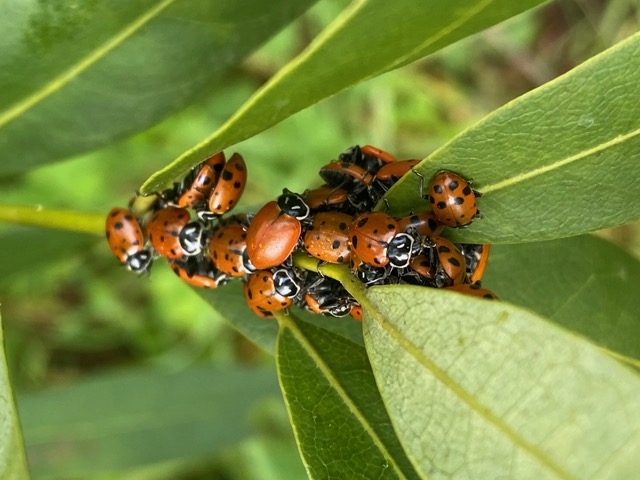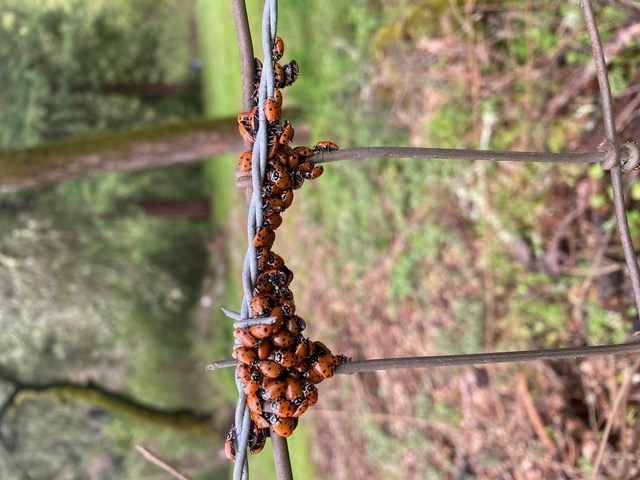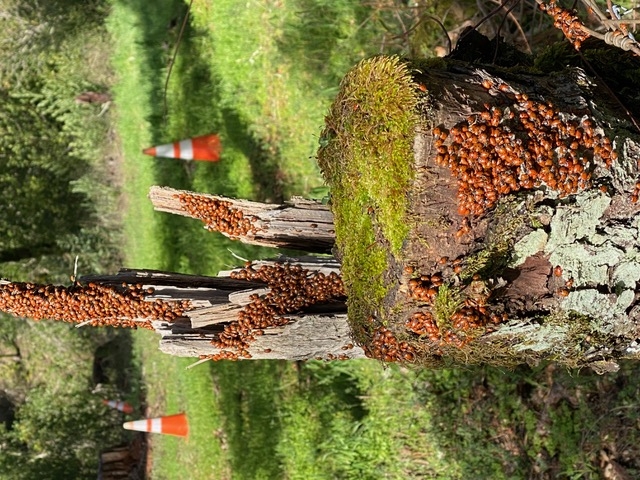On a jog up Napa's Dry Creek Road recently, I saw a magnificent sight: thousands of ladybugs clumped together on fences (even barbed wire) and on old, mossy tree stumps. The most unusual ladybug sighting was on a roadside reflector marker.
Being a first-year Master Gardener, I was determined to find out why they were all huddled together and what kind of ladybug loves to mass like this.
After much research, I learned that the ladybug I found is the convergent lady beetle (Hippodamia convergens). It is the most common lady beetle species in Napa County.
The pictures I took show a rounded, somewhat oval creature, bright orange with at least 12 black spots. This description matches the anatomy of the convergent lady beetle, aka ladybug.
Most convergent lady beetles are less than an inch long and oval, with six short legs. They are usually brightly colored with some sort of pattern, such as spots. These colors and patterns warn predators that the lady beetle not only tastes bad; she's poisonous.
These beetles have eight body parts: antennae, eyes, three body segments (head, thorax, and abdomen), legs and two pairs of wings. The area behind the head is black with a white border and two white converging lines, which is why it's called a convergent lady beetle. Adult lady beetles are easily distinguished by their bright red/orange hardened forewings with six black spots on each. The legs, head and underside are all black.
Lady beetle legs are short with segmented feet that can cling to slippery surfaces by secreting a fluid. This capability enables lady beetles to walk on glassy, smooth surfaces without slipping. That's how they were able to stay on the slippery reflector marker.
Researchers are developing new adhesive technologies modeled on this feature. .
The first cold weather signals to lady beetles that it's time to search for a warmer place to spend the winter. They are cold-blooded insects that need external heat to keep their bodies at the right temperature. During hibernation, they'll often gather in groups for warmth.
The forest on Dry Creek Road that these lady beetles picked was a perfect spot to overwinter. I found them hiding in tree bark and nooks of oak trees.
In our area, they start hibernating around mid-October. Their metabolism slows and they enter a state of sleep. During this time, they sustain themselves with the fat reserves they stored in summer.
What happens next in the lady beetle's life cycle? Once they leave the moist forest in spring, they will need to track down food to rebuild their stamina. They adjust their life cycle according to the availability of aphids.
Lady beetles develop through four life stages: egg, larva, pupa, and adult. Amazingly, the females may lay as many as 1,000 eggs over a one- to three-month period beginning in the spring or early summer. Eggs are usually deposited near prey, such as aphids, in small clusters in protected places like leaves and stems.
The eggs are tiny, about 1 millimeter, and spindle shaped. The larvae are dark, and alligator shaped with three pairs of prominent legs. That would definitely give me a scare.
These larvae feed voraciously. In two weeks, one larva can eat 350 to 400 aphids. They also eat other soft-bodied insects, such as mites and insect eggs (even their own).
The newly hatched larva is in its first instar, a developmental stage that occurs between molts. The larva feeds until it is too big for its soft shell, then it molts.
Ladybug larvae usually molt through four instars, or larval stages, before preparing to pupate. Here the larva attaches itself to a leaf or other surface as it prepares to metamorphose into adult form. The newly formed adults are vulnerable to predators until their shells, or cuticles, harden. They will soon develop the beautiful colors I saw on my jog.
You can keep aphid populations down by controlling ants and washing dust off plants. Ants protect aphids, so controlling ants keeps ladybugs free to take care of the aphids.
I've seen containers of lady beetles for sale in stores to help control the aphids we get on our roses and other plants in our gardens. If you purchase lady beetles for aphid control, wet your plants first and release the beetles in late evening when it's cooler. Those steps may keep the lady beetles in your garden longer. Growing flowering plants, which provide pollen and nectar, will also help keep ladybugs from moving on.
To protect lady beetles, please avoid using broad-spectrum persistent insecticides. The UC IPM website has a lot more information on lady beetles.
I went back to the site of the beetles on Dry Creek Road after a big storm and most were gone. Hopefully, they found a better place to hide and stay dry.
Workshop: Join UC Master Gardeners of Napa County for “Spring into Summer Vegetable Garden” on Saturday, March 17, from 2 pm to 4 pm, at Yountville Community Center, 6516 Washington Street, Yountville. Plan your vegetable growing for the warm weather ahead. Topics include soil prep, fertilizing, managing pests, irrigation, and planting schedules. This is a hands-on workshop and registration is required. To register, contact the Yountville Parks and Recreation Department.
Workshop: Join UC Master Gardeners of Napa County for “Home Vineyards: Important Information for a Successful 2024,” on Saturday, March 30, from 9 am to 12:30 pm.
Learn the latest about irrigation and treating viruses and mildew. Get up to date on climate change, soil health and structure, increasing soil organic matter and what happens in the vineyard post pruning. Workshop will be held in a barn at a private home vineyard near Napa. Attendance is free but you must register to get the address and additional details. https://surveys.ucanr.edu/survey.cfm?surveynumber=42128Help Desk: The Master Gardener Help Desk is available to answer your garden questions on Mondays and Fridays from 10 a.m. until 1 p.m. at the University of California Cooperative Extension Office, 1710 Soscol Avenue, Suite 4, Napa. Or send your questions to mastergardeners@countyofnapa.org. Include your name, address, phone number and a brief description.
*With apologies to the Isley Brothers
Attached Images:



